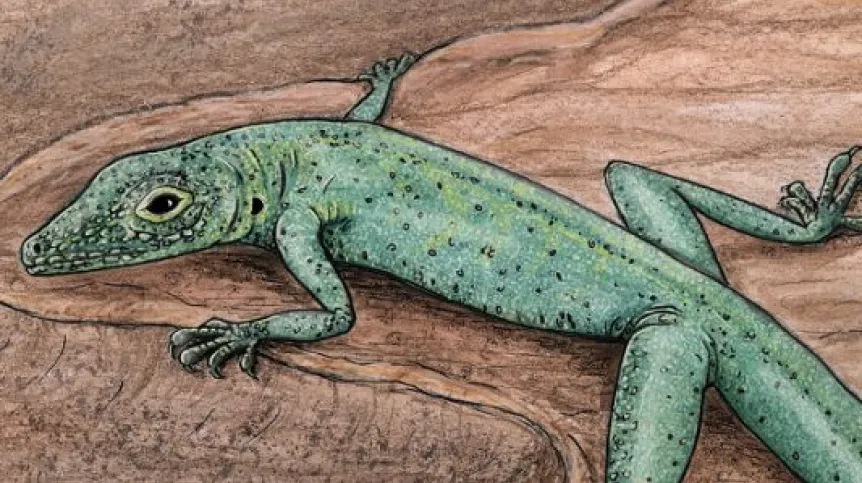
A Scottish fossil described in the journal Nature by a team led by a Polish scientist has become a source of information about the early evolution of lizards at the era of dinosaurs.
The tiny skeleton discovered on the Isle of Skye, called Bellairsia gracilis, is only 6-cm-long and dates from the Middle Jurassic, 166 million years ago. This makes it the most complete fossil lizard of this age anywhere in the world.
Bellairsia's skeleton has a mixture of ancestral and modern features, providing evidence of what the ancestor of today's squamates (the animal group that includes lizards, amphisbaenians and snakes) might have looked like.
The results of joint research by scientists from universities in Warsaw, London and Oxford have just appeared in the journal Nature.
The paper’s lead author Dr. Mateusz Tałanda said: “This little fossil lets us see evolution in action. In palaeontology you rarely have the opportunity to work with such complete, well-preserved fossils coming from a time about which we know so little.”
The exceptional new fossil comprises a near-complete skeleton (missing only the snout and tail) in life-like articulation.
To study the specimen, the team used X-ray computed tomography that allows for non-invasive 3D imaging. This revealed the entire fossil, mostly hidden by surrounding rock. The Oxford University CT scanner provided data of the full skeleton, showing details down to a few tens of micrometres. Parts of the skeleton were then imaged in even greater detail at the European Synchrotron (ESRF, Grenoble, France). The intensity of the synchrotron beam permits a resolution of 4 µm, revealing details of the smallest bones in the skeleton.
According to Dr. Tałanda, 'Bellairsia has some modern lizard features, like traits related to cranial kinesis. This is an important functional feature of many living squamates'.
The fossil was found in 2016 by a team from Oxford University and National Museums Scotland. It is one of several new fossil discoveries from the Isle of Skye, including early amphibians and mammals, which are revealing evolution of important animal groups that persist to the present day.
The paper’s co-author, Dr. Elsa Panciroli (Oxford University Museum of Natural History and National Museums Scotland) who discovered the fossil, said: “It was one of the first fossils I found when I began working on Skye. The little black skull was poking out from the pale limestone, but it was so small I was lucky to spot it. Looking closer I saw the tiny teeth, and realised I’d found something important, but we had no idea until later that almost the whole skeleton was in there.”
Squamates include lizards and snakes, and comprise more than 10,000 species living today. They include animals as diverse as pythons, sand lizards, anguids, amphisbaenians, chameleons and geckos.
Although we know the earliest origins of squamates lie 240 million years ago in the Triassic, a lack of fossils from the Triassic and Jurassic has made their early evolution and anatomy difficult to trace.
Co-author Professor Susan Evans (University College London), who first described and named Bellairsia from a few jaw and skull bones from Oxfordshire 25 years ago, added: "It is wonderful to have a complete specimen of this tantalising little lizard, and to see where it fits in the evolutionary tree. Through fossils like Bellairsia we are gaining a better understanding of early lizard anatomy. Angus Bellairs, the lizard embryologist after which Bellairsia was originally named, would have been delighted.”
The analyses of the new fossil alongside living and extinct fossil squamates confirm that Bellairsia belongs to the 'stem' of the squamate family tree, meaning that it split from other lizards just before the origin of modern groups.
The research also supports the finding that geckos are a very early branching lineage, and that the enigmatic fossil Oculudentavis, previously suggested to be a dinosaur, is also a stem squamate.
The study led by Dr Mateusz Tałanda involved researchers from the University of Oxford, University College London, the European Synchrotron Radiation Facility, the Natural History Museum in London, Oxford University Museum of Natural History and National Museums of Scotland.
Funding was provided by the Polish Ministry of Science and Higher Education (Mobility Plus programme)
PAP - Science in Poland, Ludwika Tomala
lt/ agt/ kap/
tr. RL












